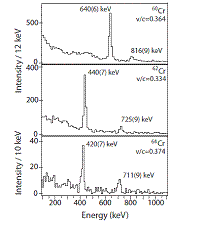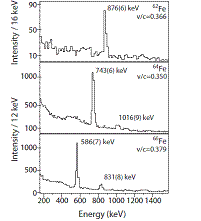Physics Division Research Highlights
Disappearance of the shell closure at neutron number 40 in neutron-rich nuclei
Shell structure is generally viewed as the cornerstone of any satisfactory description of the nucleus. It is akin to atomic shell structure in that it results in enhanced stability. Nuclei with a ‘magic’ number of protons and/or neutrons (2, 8, 20, 28, 40, 50, and 82) have a full outer shell and are characterized by a large energy gap to the next available shell. They are tightly bound as a result. For neutrons, there is an additional such number: N=126. Over the past decade, the existence of magic numbers has been called into question as a result of studies of nuclei far from stability.It seems that the large energy gaps are not all that robust and change with proton and neutron number. There is experimental proof that exotic nuclei expected to be magic are not particularly tightly bound, while other nuclei signal the presence of new magic numbers. For example, experiments at ATLAS have demonstrated that a new shell gap appears at neutron number N=32 in nuclei just above 48Ca [1, 2].
A new experiment by the ANL-NSCL-U. Manchester-U. Maryland collaboration has now demonstrated that the shell gap at N=40 vanishes in neutron-rich Cr and Fe nuclei. Generally speaking, the description of nuclei with N = 40 challenges theory as they are the subject of particularly rapid structural evolution: N = Z = 40 80Zr is strongly deformed while Z = 28, N = 40 68Ni has the characteristics of a magic nucleus (a high-lying 2+ first excited state and small quadrupole collectivity). For the N = 40 isotones, the most extreme proton-neutron asymmetry reachable today occurs in 64Cr. New measurements have now measured the excitation energy of the first excited 2+ and 4+ states and first signatures of collectivity were derived. Furthermore, data were also obtained for the N=40 Fe isotone (66Fe) and they indicate a significant change in structure between the two isotones.


Figure 1: Gamma-ray spectra detected in coincidence with scattered 60,62,64Cr (left) and 62,64,66Fe (right) projectiles. The dominant peak in each spectrum corresponds to the decay from the first 2+ level to the ground state; the second, weaker transition is associated with the deexcitation from the first 4+ level.
The measurement was performed at the National Superconducting Cyclotron Laboratory (NSCL) using 60,62,64Cr and 62,64,66Fe secondary beams. Gamma rays produced in the inelastic scattering with a thick 9Be target were detected in coincidence with the Cr and Fe fragments. In coincidence with 64Cr, two transitions were detected (Fig. 1), establishing the energy of the 2+ and 4+ states as E(2+)=420(7) and E(4+)=1131(11) keV. The corresponding excitations in 66Fe are 586(7) and 1417(11) keV. These new 2+ excitations are by far the lowest in the N=40 neutron-rich nuclei and are an indication that the N=40 shell gap no longer exists in these nuclei; i.e., the shell closure has been “washed out”. Furthermore, the ratio R between the 2+ and 4+ energies provides a convenient classification of structural properties in terms of non-collective (<2.0), spherical-vibrational (∼2.0), transitional (∼2.5), or rigid-rotor (∼3.33) regimes. This R ratio increases steeply toward a transitional character between N = 30 and 40 in the Cr isotopic chain. In contrast, it remains constant and even decreases slightly in the corresponding Fe chain. The difference in the R ratio and in the relative behavior of the measured excitation cross sections(not shown) points to a different intrinsic structure for the two N=40 isotopes. A paper reporting these results has recently been published [3].
References:
- R.V.F. Janssens et al., Phys. Lett. B 546, 55 (2002).
- S. Zhu et al., Phys. Rev. C 74, 064315 (2006) and Phys. Rev. C 80, 024318 (2009).
- A. Gade, R.V.F. Janssens et al., Phys. Rev. C 81, 051304(R) (2010).
![[Argonne Logo]](/images/argonne_header_logo.jpg)
![[DOE Logo]](/images/header_doe.gif)